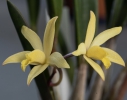|
|
|
|
|
| |
Flasks of
Laelia bradei 'MC8302' -spontaneous |
|
| |
|
|
| |
| Number: |
TN9407 |
| Name: |
Laelia bradei 'MC8302' -spontaneous
|
| Type: |
spontaneous (What's that?) |
|
Click to Enlarge

Pod Parent Flowers |
|
|
|
| |
Culture Notes from Donor: Parent plant: Temperature range Warm 90-70°F, cooler season Cool 70-52°F.
Does well grown in a small (just large enough to fit the root mass) terracotta pot tightly filled with sphagnum moss. Needs very high light; kept outdoors in Pennsylvania during warmer months, and in a fully exposed east-facing window once the temperatures drop into the 40°Fs at night. Watered when sphagnum is dry (2-3 times a week during the summer; 1-2 times a week during cooler months). Fertilizer provided from spring through fall.
Comments: Parent plant: Plant originally purchased from Miranda Orchids in September, 2021.
Slender pseudobulbs 5-6 cm tall, approx. 1 cm at the base and tapering to 0.5 cm at the apex, from which stems a single stiff, fleshy, upright but gently reflexed leaf, 6-9 cm long, and strongly channeled/cupped along the midrib. Total vegetative plant height is approximately 15 cm. Leaves and pseudobulbs are dark green, and flushed with red if receiving adequate light. Pseudobulbs grow on very short rhizomes, forming dense clusters.
Inflorescences grow from the apex of the pseudobulb, and develop within the still-closed leaves on the newest growths, such that the buds appear as the leaf opens. Scapes measure 3-4 cm, so that the pale yellow, star-shaped, crystalline flowers sit at about the center of the leaf. Produces 1-2 flowers per scape. Blooms in early fall.
For additional origin/habitat information supplied courtesy of
Charles and Margaret Baker, see further below, near the bottom of this page.
|
Temperatures we attempt to use in the lab & greenhouse:
| For Species: |
|
Spring, Summer, Autumn: days average 77°F, nights 62°F; best fit is Cool-Intermediate 75-58°F
(Source:
Baker's Web OSC) |
| For Species: |
|
Winter: days average 71°F, nights 53°F; best fit is Cool 70-52°F
(Source:
Baker's Web OSC) |
|
About the name...
| Etymology of |
Laelia |
|
One of the vestal virgins, Laelia.
(Source:
Pridgeon 1992) |
| Pronunciation of |
Laelia |
|
LAY-lee-ah
(Source:
Pridgeon 1992) |
|
If you would like to direct someone to this web page, please copy and paste this URL into your email:
http://troymeyers.com/d?019407
| Flask Information |
| Availability: |
Capsules have been harvested, and we are waiting for germination. |
| You should: |
Make a notification request now.
When this germinates, we'll let you know, and you can reserve a flask at that time if you like. Your notification request serves as a place-holder in line for flasks later, so it's best if you place the notification request as early as possible. If you wait, you'll be further down in line for flasks. |
| Expected Flask Price: |
$40.00 per flask of 16 (min.) plants
Plants proliferate if crowded, so are planted more sparsely than usual.
|
|
You might also want to:
|
View the seed assay for this item.
View items of the same species.
View items of the same genus.
|
| Ordering Information |
| You are not currently logged in. |
|
You must be a registered user and be logged in to reserve a flask or place a notification request. Please log in:
|
|
|
|
|
|
| |
The origin/habitat information below is supplied courtesy of Charles and Margaret Baker
The following information is based on the name of the plant provided by the donor, and assumes that the name is correct. If the plant has been misidentified, then the following information may not be correct.
This text is copyrighted by the Bakers and may not be reproduced without permission.
ORIGIN/HABITAT: Brazil. Plants were originally discovered at about 4250
ft. (1300 m) near Diamantina in the state of Minas Gerais but have since
been found in the state of Espírito Santo at about 3950 ft. (1200 m).
Plants grow in cracks and crevices on lichen-covered rocks.
More about this information and the Bakers...
|
|
|
| |
|
|
|